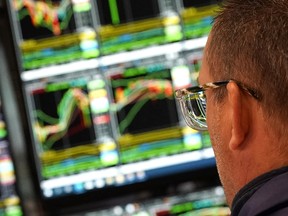
Article content
The steep recovery in equity markets over the past two weeks is typical of bear market rallies, and the erratic swings mean almost every investor will experience pain whichever direction the market suddenly moves.
THIS CONTENT IS RESERVED FOR SUBSCRIBERS ONLY
Subscribe now to read the latest news in your city and across Canada.
- Exclusive articles from Barbara Shecter, Joe O'Connor, Gabriel Friedman, and others.
- Daily content from Financial Times, the world's leading global business publication.
- Unlimited online access to read articles from Financial Post, National Post and 15 news sites across Canada with one account.
- National Post ePaper, an electronic replica of the print edition to view on any device, share and comment on.
- Daily puzzles, including the New York Times Crossword.
SUBSCRIBE TO UNLOCK MORE ARTICLES
Subscribe now to read the latest news in your city and across Canada.
- Exclusive articles from Barbara Shecter, Joe O'Connor, Gabriel Friedman and others.
- Daily content from Financial Times, the world's leading global business publication.
- Unlimited online access to read articles from Financial Post, National Post and 15 news sites across Canada with one account.
- National Post ePaper, an electronic replica of the print edition to view on any device, share and comment on.
- Daily puzzles, including the New York Times Crossword.
REGISTER / SIGN IN TO UNLOCK MORE ARTICLES
Create an account or sign in to continue with your reading experience.
- Access articles from across Canada with one account.
- Share your thoughts and join the conversation in the comments.
- Enjoy additional articles per month.
- Get email updates from your favourite authors.
THIS ARTICLE IS FREE TO READ REGISTER TO UNLOCK.
Create an account or sign in to continue with your reading experience.
- Access articles from across Canada with one account
- Share your thoughts and join the conversation in the comments
- Enjoy additional articles per month
- Get email updates from your favourite authors
Sign In or Create an Account
or
Article content
Article content
Goldman Sachs Group Inc. strategist Peter Oppenheimer said “the asymmetry for equity investing is poor. Sharp rallies within bear markets are the norm, not the exception.”
Article content
Article content
The biggest market driver is still uncertainty, with no real long-term bullish or bearish conviction seen from investors. Price action is mainly fuelled by short-term headlines and guesswork on how the quickly evolving U.S. tariffs story will be told through corporate earnings and resetting valuations.
Article content
Article content
By signing up you consent to receive the above newsletter from Postmedia Network Inc.
Article content
“If the tariff announcements are reversed quickly with little lasting economic damage, this does suggest that the downside risks are limited. Nonetheless, at current valuations, we also think the upside is limited,” Oppenheimer wrote in a note.
Article content
Investing becomes far more difficult in such a regime, when both upside and downside are seen as limited and decision making is caught in foggy headline risk. Market participants have to choose between chasing a fading rally then risk exiting too late, or missing out entirely on another squeeze higher. They want to avoid trap doors in a tricky macroeconomic environment while still being able to capture opportunities.
Article content
“This equities trade is nasty, and the one scenario that nobody wanted,” Nomura Securities cross-asset strategist Charlie McElligott said. Many investors were forced to de-risk when there was zero visibility on tariffs in early April, but are now being forced to buy into a rally very few had enough exposure to fully benefit from its performance.
Article content
Article content
There is confirmation of “holding your nose and forced to buy-back exposure” playing out in stock-index options, “despite most investors hating the eventual macro growth outlook ahead,” McElligott wrote in a note.
Article content
Article content
If history is any guide, one of the sharpest intra-month rebounds in stock market history in April may have exhausted gains. Since 1980, the global stock market underwent several bear market rallies, which on average lasted for 44 days and saw gains of 14 per cent. And while this year’s global stocks decline isn’t officially a bear market, prices were up 18 per cent Wednesday from an intraday low hit on April 7.
Article content
“Rates and risk assets will continue to be headline driven,” said Academy Securities macro strategist Peter Tchir. “Policies and deals will take their turns driving markets.” On the plus side are indications of “some cooling” in the U.S. tariff stance on China as well as the U.S. budget getting going, but with the Fed unlikely to help as of now, “a lot has already been priced in,” he noted.
Article content
The funding spread — a measure of demand for long exposure through equity derivatives such as swaps, options and futures — has decoupled from the latest leg higher in stocks. “This suggests macro investors trimmed their equity exposure on the recent strength,” Goldman Sachs managing director John Marshall wrote in a separate note.

.jpg) 4 hours ago
1
4 hours ago
1
 English (US)
English (US)